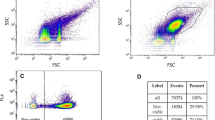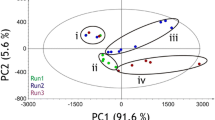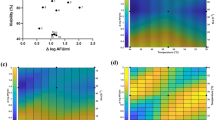Abstract
Here, we report on a highly sensitive method for the detection of P(3HB) accumulation in Escherichia coli cells based on the automated flow cytometry system using fluorescent dyes. E. coli containing P(3HB) were stained with either BODIPY or Nile red fluorescent dye, and their staining properties were analyzed under a variety of conditions. Compared with Nile red, BODIPY was much more sensitive in staining P(3HB) and overall demonstrated a more rapid staining of cells, a greater resistance to photobleaching, and greater cell viability. In addition, we also successfully monitored heterogeneity in P(3HB) accumulation within a cell population using BODIPY staining and flow cytometry. We believe this optimized staining method using BODIPY in combination with screening by high-speed flow cytometer will be helpful in the engineering of host cells toward an enhanced production of bioplastics.





Similar content being viewed by others
References
Keshavarz, T., & Roy, I. (2010). Polyhydroxyalkanoates: Bioplastics with a green agenda. Current Opinions in Microbiology, 13, 321–326.
Lee, S. Y. (1996). Bacterial polyhydroxyalkanoates. Biotechnology and Bioengineering, 49, 1–14.
Gao, X., Chen, J. C., Wu, Q., & Chen, G. Q. (2011). Polyhydroxyalkanoates as a source of chemicals, polymers, and biofuels. Current Opinions in Biotechnology, 22, 768–774.
Grage, K., Jahns, A. C., Parlane, N., Palanisamy, R., Rasiah, I. A., Atwood, J. A., & Rehm, B. H. (2009). Bacterial polyhydroxyalkanoate granules: Biogenesis, structure, and potential use as nano-/micro-beads in biotechnological and biomedical applications. Biomacromolecules, 10, 660–669.
Madhavan Nampoothiri, K., Nair, N. R., & John, R. P. (2010). An overview of the recent developments in polylactide (PLA) research. Bioresource Technology, 101, 8493–8501.
Park, S. J., Kim, M. K., & Lee, S. Y. (2012). Microbial metabolic engineering for the production of polyesters. Biotechnology International, 24, 11–13.
Choi, J., & Lee, S. Y. (1999). Factors affecting the economics of polyhydroxyalkanoate production by bacterial fermentation. Applied Microbiology and Biotechnology, 51, 13–21.
Lee, S. Y., Park, S. J., Park, J. P., Lee, Y., & Lee, S. H. (2004). Economic aspects of biopolymer production, in biotechnology of biopolymers (pp. 1107–1138). Weinheim, Germany: VCH-Wiley.
Givan, A. L. (2011). Flow cytometry: An introduction. Methods in Molecular Biology, 699, 1–29.
Mattanovich, D., & Borth, N. (2006). Applications of cell sorting in biotechnology. Microbial Cell Factories, 5, 12.
Spiekermann, P., Rehm, B. H., Kalscheuer, R., Baumeister, D., & Steinbuchel, A. (1999). A sensitive, viable-colony staining method using Nile red for direct screening of bacteria that accumulate polyhydroxyalkanoic acids and other lipid storage compounds. Archives of Microbiology, 171, 73–80.
Ostle, A. G., & Holt, J. G. (1982). Nile blue A as a fluorescent stain for poly-beta-hydroxybutyrate. Applied and Environmental Microbiology, 44, 238–241.
Schlegel, H. G., Lafferty, R., & Krauss, I. (1970). The isolation of mutants not accumulating poly-β-hydroxybutyric acid. Archives in Mikrobiology, 71, 283–294.
Amara, A. A., Steinbüchel, A., & Rehm, B. H. (2002). In vivo evolution of the Aeromonas punctata polyhydroxyalkanoate (PHA) synthase: Isolation and characterization of modified PHA synthases with enhanced activity. Applied Microbiology and Biotechnology, 59, 477–482.
Kichise, T., Taguchi, S., & Doi, Y. (2002). Enhanced accumulation and changed monomer composition in polyhydroxyalkanoate (PHA) copolyester by in vitro evolution of Aeromonas caviae PHA synthase. Applied and Environmental Microbiology, 68, 2411–2419.
Govender, T., Ramanna, L., Rawat, I., & Bux, F. (2012). BODIPY staining, an alternative to the Nile red fluorescence method for the evaluation of intracellular lipids in microalgae. Bioresource Technology, 114, 507–511.
Kacmar, J., Carlson, R., Balogh, S. J., & Srienc, F. (2006). Staining and quantification of poly-3-hydroxybutyrate in Saccharomyces cerevisiae and Cupriavidus necator cell populations using automated flow cytometry. Cytometry. Part A, 69, 27–35.
Niu, S. L., Ulrich, G., Retailleau, P., Harrowfield, J., & Ziessel, R. (2009). New insights into the solubilization of BODIPY dyes. Tetrahedron Letters, 50, 3840–3844.
Yang, T. H., Kim, T. W., Kang, H. O., Lee, S. H., Lee, E. J., Lim, S. C., Oh, S. O., Song, A. J., Park, S. J., & Lee, S. Y. (2010). Biosynthesis of polylactic acid and its copolymers using evolved propionate CoA transferase and PHA synthase. Biotechnology and Bioengineering, 105, 150–160.
Braunegg, G., Sonnleitner, B., & Lafferty, R. M. (1978). A rapid gas chromatographic method for the determination of poly-β-hydroxybutyric acid in microbial biomass. European Journal of Applied Microbiology and Biotechnology, 6, 29–37.
Choi, J., Lee, S. Y., Shin, K., Lee, W. G., Park, S. J., Chang, H. N., & Chang, Y. K. (2002). Pilot scale production of poly(3-hydroxybutyrate-co-3-hydroxyvalerate) by fed-batch culture of recombinant Escherichia coli. Biotechnology and Bioprocess Engineering, 7, 371–374.
Cooksey, K. E., Guckert, J. B., Williams, S., & Callis, P. R. (1987). Fluorometric determination of the neutral lipid content of microalgal cells using Nile red. Journal of Microbiological Methods, 6, 333–345.
Doan, T. T. Y., Sivaloganathan, B., & Obbard, J. P. (2011). Screening of marine microalgae for biodiesel feedstock. Biomass and Bioenergy, 35, 2534–2544.
Chen, W., Zhang, C., Song, L., Sommerfeld, M., & Hu, Q. (2009). A high throughput Nile red method for quantitative measurement of neutral lipids in microalgae. Journal of Microbiological Methods, 77, 41–47.
Tyo, K. E., Zhou, H., & Stephanopoulos, G. N. (2006). High-throughput screen for poly-3-hydroxybutyrate in Escherichia coli and Synechocystis sp. strain PCC6803. Applied and Environmental Microbiology, 72, 3412–3417.
Park, S. J., Park, J. P., & Lee, S. Y. (2002). Production of poly(3-hydroxybutyrate) from whey by fed-batch culture of recombinant Escherichia coli in a pilot-scale fermentor. Biotechnology Letters, 24, 185–189.
Han, M.-J., Park, S. J., Lee, J. W., Min, B. H., Lee, S. Y., Kim, S.-J., & Yoo, J.-S. (2006). Analysis of poly(3-hydroxybutyrate) granule-associated proteome in recombinant Escherichia coli. Journal of Microbiology and Biotechnology, 16, 901–910.
Han, M. J., Yoon, S. S., & Lee, S. Y. (2001). Proteome analysis of metabolically engineered Escherichia coli producing poly(3-hydroxybutyrate). Journal of Bacteriology, 183, 301–308.
York, G. M., Stubbe, J., & Sinskey, A. J. (2001). New insight into the role of the PhaP phasin of Ralstonia eutropha in promoting synthesis of polyhydroxybutyrate. Journal of Bacteriology, 183, 2394–2397.
Acknowledgments
This work was supported by the Intelligent Synthetic Biology Center of Global Frontier Project funded by the Ministry of Science, ICT, and Future Planning (MSIP). Further support from the 2012 Research Fund of Myongji University is appreciated.
Author information
Authors and Affiliations
Corresponding authors
Additional information
Jae Hyung Lee and Seung Hwan Lee equally contributed to this work.
Electronic supplementary material
Below is the link to the electronic supplementary material.
ESM 1
(PPTX 3718 kb)
Rights and permissions
About this article
Cite this article
Lee, J.H., Lee, S.H., Yim, S.S. et al. Quantified High-Throughput Screening of Escherichia coli Producing Poly(3-hydroxybutyrate) Based on FACS. Appl Biochem Biotechnol 170, 1767–1779 (2013). https://doi.org/10.1007/s12010-013-0311-2
Received:
Accepted:
Published:
Issue Date:
DOI: https://doi.org/10.1007/s12010-013-0311-2




